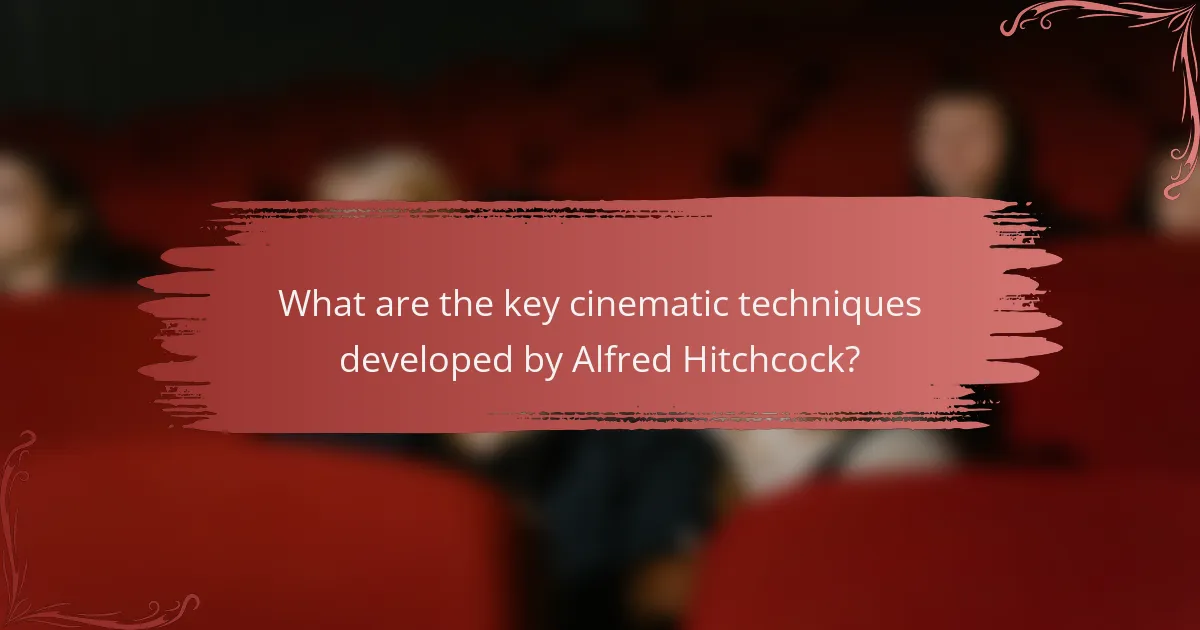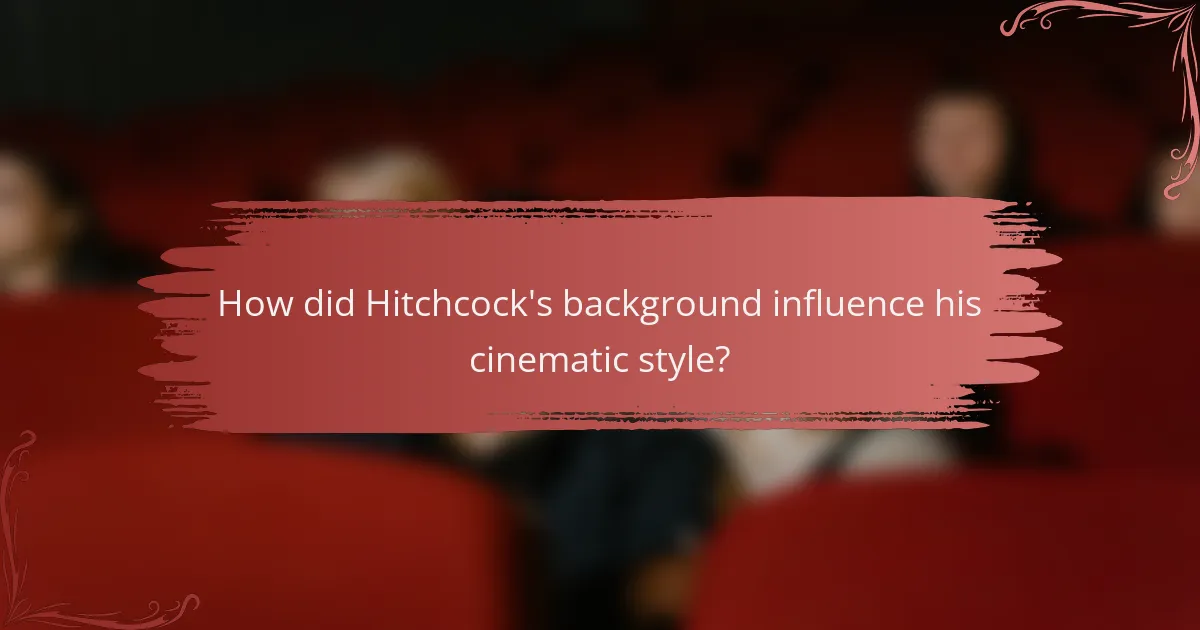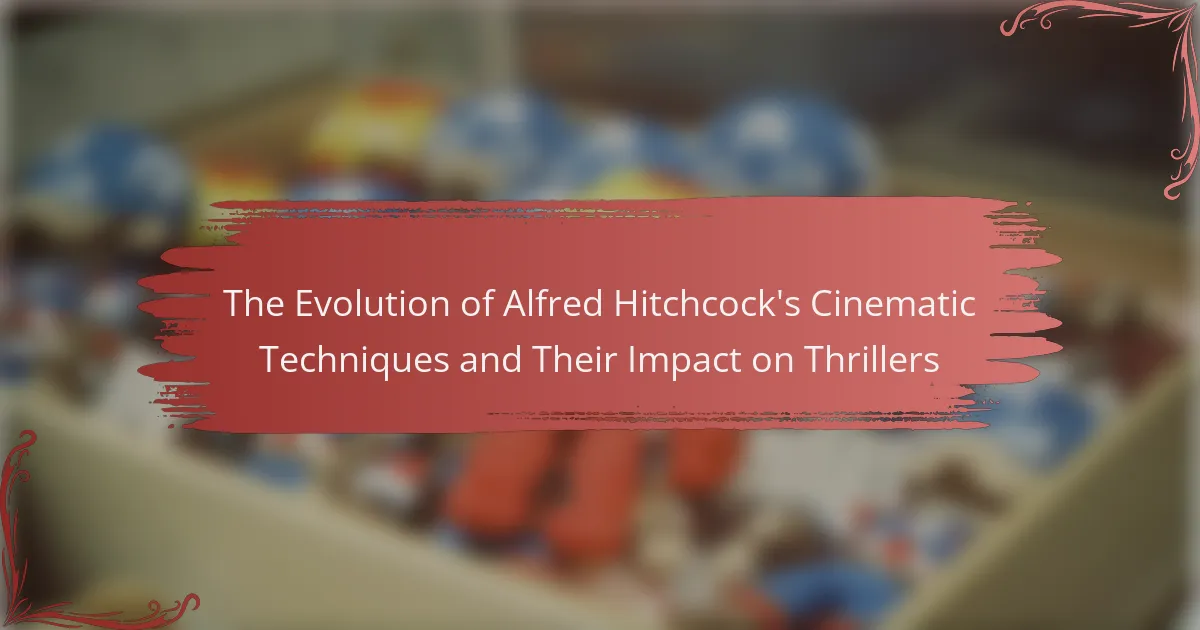Alfred Hitchcock is a pivotal figure in the evolution of the thriller genre, renowned for his innovative cinematic techniques that have significantly influenced filmmaking. Key techniques developed by Hitchcock include suspenseful editing, the “match cut,” and the “dolly zoom,” which enhance tension and create a disorienting effect. He introduced the “Hitchcockian twist,” unexpected plot developments that surprise audiences, and utilized “point-of-view shots” to deepen emotional engagement. Hitchcock’s use of “MacGuffins” as plot devices and his strategic use of sound further elevated his storytelling. His background in theater and silent films informed his unique style, shaping his approach to suspense and psychological depth in characters, which continues to inspire filmmakers today.

What are the key cinematic techniques developed by Alfred Hitchcock?
Alfred Hitchcock developed several key cinematic techniques that transformed the thriller genre. One prominent technique is the use of suspenseful editing, particularly the “match cut” to create tension. He often employed the “Hitchcockian twist,” where unexpected plot developments surprise the audience. Another technique is the use of the “dolly zoom,” which creates a disorienting effect by altering the camera’s distance from the subject while zooming in or out. Hitchcock also mastered the art of “point-of-view shots,” allowing viewers to see through the eyes of characters, enhancing emotional engagement. Additionally, he utilized “MacGuffins,” plot devices that drive the story but may not be significant in themselves. His innovative use of sound, such as the absence of music in tense scenes, heightened suspense. Hitchcock’s techniques have had a lasting influence on filmmaking and continue to be studied and emulated today.
How did Hitchcock’s use of suspense redefine thriller films?
Hitchcock’s use of suspense redefined thriller films by prioritizing psychological tension over mere shock. He introduced the concept of “dramatic irony,” where the audience knows more than the characters. This technique heightened emotional engagement and anticipation. His films often featured prolonged sequences of suspense, such as the famous shower scene in “Psycho.” Hitchcock also employed innovative camera techniques to manipulate viewer perception. For instance, he used close-ups to capture characters’ emotions. His careful pacing built tension, making audiences more invested in the outcome. Overall, Hitchcock’s mastery of suspense set a new standard for the thriller genre.
What specific techniques did Hitchcock employ to create suspense?
Hitchcock employed several specific techniques to create suspense in his films. He utilized the “MacGuffin,” an object that drives the plot but holds varying significance for different characters. This technique keeps audiences engaged while focusing on character motivations. He also mastered the use of “dramatic irony,” where the audience knows more than the characters, increasing tension. Another technique was the “slow reveal” of information, allowing suspense to build gradually. Hitchcock often employed long takes to create a sense of real-time urgency. He used music and sound design strategically to enhance emotional responses. Additionally, he manipulated camera angles and lighting to create unease and highlight character emotions. These techniques have been widely analyzed and celebrated in film studies, showcasing Hitchcock’s profound impact on the thriller genre.
How does the concept of ‘MacGuffin’ play a role in his storytelling?
The concept of ‘MacGuffin’ serves as a crucial plot device in Alfred Hitchcock’s storytelling. A MacGuffin is an object or goal that drives the plot forward but is often of little intrinsic value. Hitchcock used MacGuffins to engage the audience’s interest and propel characters into action. For instance, in “North by Northwest,” the pursuit of a secret microfilm motivates the protagonist’s journey. This technique allows Hitchcock to focus on character development and suspense rather than the object itself. The MacGuffin often remains ambiguous, keeping viewers intrigued. Hitchcock’s masterful use of this device illustrates his innovative approach to narrative structure in thrillers.
What innovations did Hitchcock introduce in film editing and cinematography?
Hitchcock introduced several key innovations in film editing and cinematography. He popularized the use of montage to create suspense and convey emotions. His technique of “cross-cutting” allowed simultaneous storytelling across different scenes. Hitchcock also employed the “dolly zoom,” creating a disorienting effect that enhances tension. He utilized the “long take” to maintain continuous action and immerse viewers. His use of lighting shaped mood and character perception. Hitchcock’s innovative camera angles and perspectives added depth to narrative storytelling. These techniques have significantly influenced modern filmmaking and thriller genres.
How did Hitchcock’s editing style contribute to narrative pacing?
Hitchcock’s editing style significantly enhanced narrative pacing in his films. He employed techniques such as rapid cuts and montage sequences to create tension. This approach allowed for a quick transition between scenes, maintaining viewer engagement. His use of suspenseful editing, particularly in films like “Psycho,” heightened emotional responses. Hitchcock often juxtaposed contrasting shots to emphasize dramatic moments. This technique kept audiences on the edge of their seats. Additionally, he strategically used longer takes to build anticipation before critical events. Overall, his editing choices directly influenced the rhythm and flow of the story, making his thrillers more impactful.
What camera techniques did Hitchcock popularize in thrillers?
Hitchcock popularized several camera techniques in thrillers. He is known for using the “dolly zoom,” also called the “Vertigo effect.” This technique creates a sense of disorientation by moving the camera closer or further away while zooming in the opposite direction. Hitchcock also utilized extreme close-ups to heighten tension and emphasize characters’ emotions.
He employed the “point of view” shot to immerse viewers in the perspective of characters. Another technique was the use of long takes to build suspense, as seen in “Rope.” Hitchcock’s innovative use of lighting and shadows added a psychological depth to scenes.
These techniques collectively enhanced the narrative and emotional impact of his films, establishing a new standard for the thriller genre.

How did Hitchcock’s background influence his cinematic style?
Hitchcock’s background significantly influenced his cinematic style. His early life in London exposed him to the theater and silent films. This experience shaped his understanding of visual storytelling. Hitchcock’s work in the British film industry refined his technical skills. He developed a knack for suspense and psychological tension. His childhood experiences with fear and isolation informed his themes. These elements became central to his films. Hitchcock’s unique perspective on storytelling set him apart in the thriller genre.
What personal experiences shaped Hitchcock’s approach to filmmaking?
Alfred Hitchcock’s approach to filmmaking was shaped by several personal experiences. His childhood in London was marked by strict parental discipline. This often instilled a sense of fear and anxiety in him. Hitchcock’s early fascination with film began when he worked as a title card designer in the silent film era. This experience taught him the importance of visual storytelling.
Additionally, Hitchcock’s experiences with betrayal influenced his narratives. His relationship with women often reflected his complex views on trust and control. The trauma of his father’s death also contributed to his themes of psychological tension. Hitchcock’s experiences with censorship in the British film industry shaped his understanding of suspense.
All these factors combined to create a unique style that emphasized psychological depth and innovative techniques in thrillers.
How did Hitchcock’s early career in silent films impact his later work?
Hitchcock’s early career in silent films significantly influenced his later work in sound cinema. His experience with visual storytelling in silent films taught him the importance of imagery and composition. He developed a keen understanding of how to convey emotion and suspense without dialogue. This skill became a hallmark of his later thrillers, where visual cues often drive the narrative. Additionally, Hitchcock’s silent film background fostered his innovative use of camera angles and movement. He learned to create tension through visual techniques, which he refined in his sound films. This foundation allowed him to craft suspenseful sequences that captivated audiences. Thus, his silent film career laid the groundwork for his mastery of cinematic techniques in thrillers.
In what ways did his cultural background influence his themes?
Alfred Hitchcock’s cultural background significantly influenced his themes, particularly in his exploration of psychological complexity and suspense. Born in England, Hitchcock was shaped by Victorian values, which emphasized repression and morality. This background led him to portray themes of guilt, fear, and the darker aspects of human nature. His early experiences in a strict Catholic household also instilled a sense of guilt that permeated his characters’ motivations. Additionally, Hitchcock’s exposure to British cinema and literature enriched his narrative style, leading to intricate plots and character development. His themes often reflect the anxieties of his time, particularly regarding identity and societal expectations. This cultural lens contributed to the suspenseful and psychologically intense narratives that became hallmarks of his films.
How did Hitchcock’s films reflect societal fears and anxieties?
Hitchcock’s films reflected societal fears and anxieties through their exploration of themes like paranoia, identity, and the unknown. His works often depicted ordinary characters facing extraordinary threats. For instance, “Psycho” highlighted fears surrounding mental illness and the fragility of human identity. The shocking twist of a seemingly normal motel owner becoming a murderer resonated with audiences during a time of increasing societal instability. In “Rear Window,” the protagonist’s voyeurism raised anxieties about privacy and the nature of observation. Hitchcock’s use of suspense and tension amplified these themes, making viewers confront their own fears. The psychological depth in his characters often mirrored the anxieties of the post-war era, reflecting societal concerns about trust and safety.
What themes of paranoia are prevalent in Hitchcock’s thrillers?
Prevalent themes of paranoia in Hitchcock’s thrillers include mistrust, surveillance, and the fragility of sanity. Mistrust is often depicted through characters doubting each other’s intentions. Surveillance creates a sense of being watched, enhancing the feeling of vulnerability. The fragility of sanity is illustrated through characters experiencing psychological breakdowns. Hitchcock’s use of unreliable narrators amplifies these themes. For instance, in “Vertigo,” the protagonist’s obsession leads to a distorted perception of reality. These elements create tension and suspense, hallmark traits of Hitchcock’s storytelling.
How did historical context shape the narratives of his films?
Historical context significantly shaped the narratives of Alfred Hitchcock’s films. The societal anxieties of the early to mid-20th century influenced his storytelling. Hitchcock often reflected themes of paranoia and surveillance, mirroring the post-war climate and the rise of psychological tension in society. Events such as World War II and the Cold War heightened public fears, which he incorporated into his plots. For example, “North by Northwest” showcases themes of mistaken identity, resonating with Cold War anxieties about espionage. Additionally, the feminist movements of the 1960s impacted his portrayal of women, as seen in “Psycho,” where he explored complex female characters. Hitchcock’s films serve as a lens through which historical events and cultural shifts are examined, making them timeless yet contextually relevant.

What lasting impact did Hitchcock have on the thriller genre?
Alfred Hitchcock profoundly shaped the thriller genre through innovative storytelling and cinematic techniques. He introduced suspense as a core element, often keeping audiences on edge with carefully crafted tension. Hitchcock’s use of psychological depth in characters added complexity to narratives, elevating the genre beyond mere entertainment. His pioneering techniques, such as the use of camera angles and editing, created a sense of voyeurism. Films like “Psycho” and “Rear Window” exemplified these methods, influencing countless filmmakers. The concept of the “MacGuffin” became a staple in thrillers, driving plots while maintaining audience intrigue. Hitchcock’s mastery of misdirection established a template for modern thrillers. His legacy continues to inspire filmmakers, ensuring that his impact on the genre remains significant and enduring.
How have modern filmmakers drawn inspiration from Hitchcock’s techniques?
Modern filmmakers have drawn inspiration from Hitchcock’s techniques primarily through suspenseful storytelling and innovative camera work. They adopt his use of tension-building methods, such as the MacGuffin, to engage audiences. Filmmakers like Brian De Palma and David Fincher utilize voyeuristic perspectives reminiscent of Hitchcock’s “Rear Window.” Techniques such as the “dolly zoom,” popularized by Hitchcock in “Vertigo,” are also evident in contemporary films. Additionally, Hitchcock’s mastery of editing to create psychological tension influences modern thriller narratives. His focus on character psychology informs the development of complex antagonists in today’s cinema. These elements showcase Hitchcock’s lasting impact on the thriller genre.
What elements of Hitchcock’s style are commonly used in contemporary thrillers?
Hitchcock’s style elements commonly used in contemporary thrillers include suspense, psychological tension, and innovative camera techniques. Suspense is often built through the use of unexpected plot twists. Contemporary films frequently employ the “McGuffin,” an object that drives the plot but is not central to the story. Psychological tension is created by exploring characters’ inner conflicts, similar to Hitchcock’s focus on complex protagonists. Innovative camera techniques, such as the use of close-ups and unique angles, enhance emotional engagement. Additionally, the theme of voyeurism, prevalent in Hitchcock’s work, remains a key element in modern thrillers. These stylistic choices reflect Hitchcock’s lasting influence on the genre.
What lessons can filmmakers learn from Hitchcock’s cinematic techniques?
Filmmakers can learn the importance of suspense and tension from Hitchcock’s techniques. He masterfully built suspense through pacing and careful framing. Techniques such as the “MacGuffin” illustrate how a plot device can drive the narrative. Hitchcock’s use of camera angles created emotional responses from the audience. His emphasis on character psychology deepened viewer engagement. Filmmakers should also note his innovative use of sound to enhance atmosphere. Hitchcock’s ability to manipulate audience expectations is a crucial lesson. His films often subverted traditional narrative structures, providing fresh storytelling approaches.
How can suspense be effectively built in a modern thriller?
Suspense in a modern thriller can be effectively built through pacing, character development, and plot twists. Pacing involves controlling the rhythm of the story to create tension. This can include alternating between fast and slow scenes to heighten anticipation. Character development is crucial; audiences must care about the characters to feel invested in their fate. Detailed backstories and motivations can enhance this connection. Plot twists introduce unexpected events that challenge the audience’s assumptions. According to a study by the University of Southern California, effective pacing and character empathy significantly increase viewer engagement in thrillers. These techniques, rooted in Hitchcock’s principles, remain relevant in contemporary storytelling.
What are some best practices for using visual storytelling in thrillers?
Use suspenseful imagery to create tension in thrillers. Visual storytelling should emphasize shadows and lighting to evoke fear. Close-ups on characters’ faces can reveal emotions and heighten drama. Employ dynamic camera angles to convey a sense of urgency. Incorporate symbolism to deepen the narrative, such as objects that represent danger. Utilize pacing effectively; quick cuts can enhance excitement. Sound design should complement visuals to amplify suspense. These practices align with Hitchcock’s techniques, which often included innovative visual elements that captivated audiences.
The main entity of the article is Alfred Hitchcock, a pivotal figure in the evolution of cinematic techniques within the thriller genre. The article explores Hitchcock’s innovative methods, such as suspenseful editing, the use of the “MacGuffin,” and psychological depth in character development, which transformed storytelling in film. It also examines how his background influenced his cinematic style and the lasting impact of his techniques on modern filmmaking. Key themes discussed include the manipulation of viewer perception, the role of suspense, and the reflection of societal fears in his narratives. Overall, the article provides a comprehensive overview of Hitchcock’s contributions to film and their relevance in contemporary thrillers.
